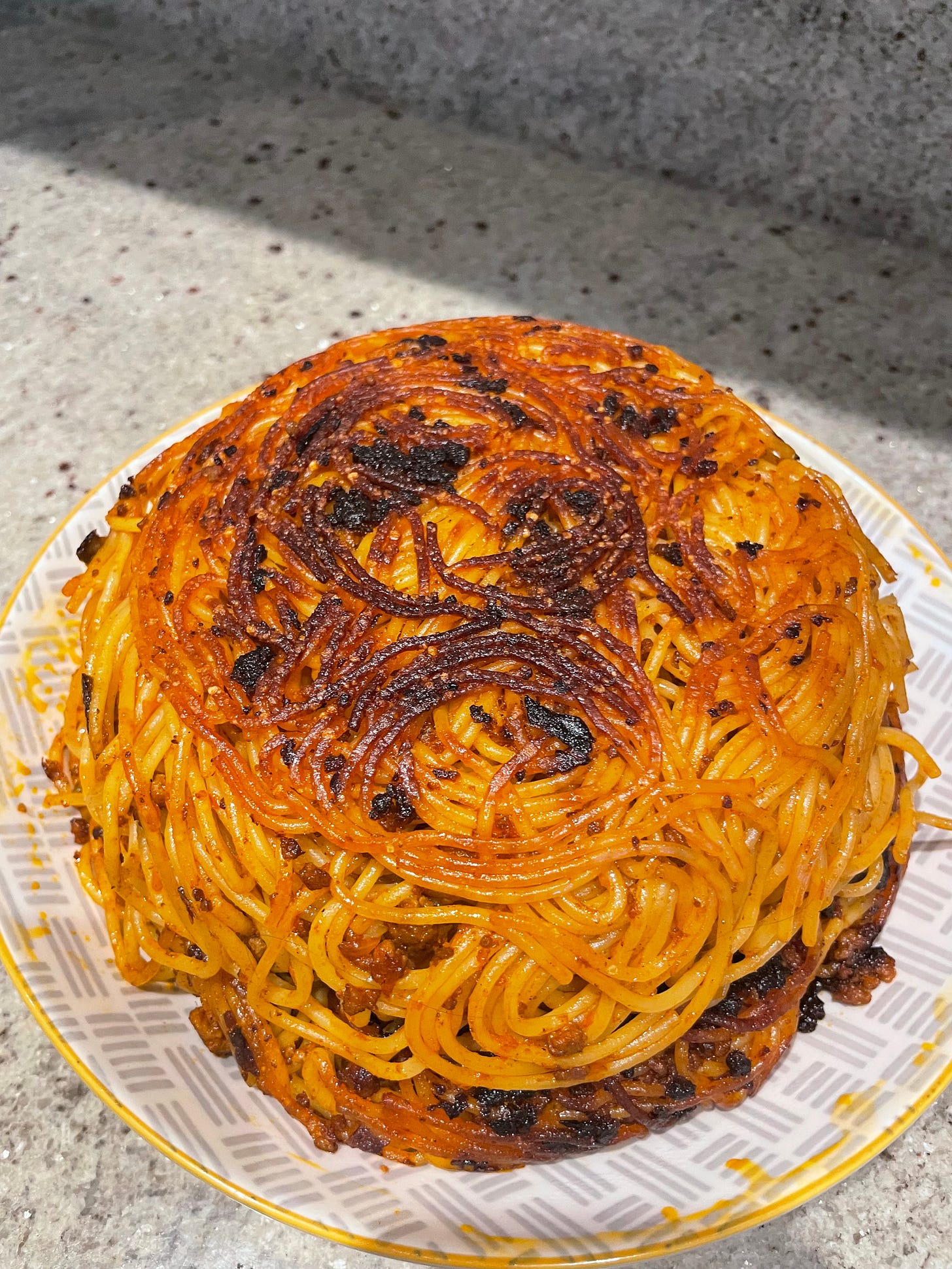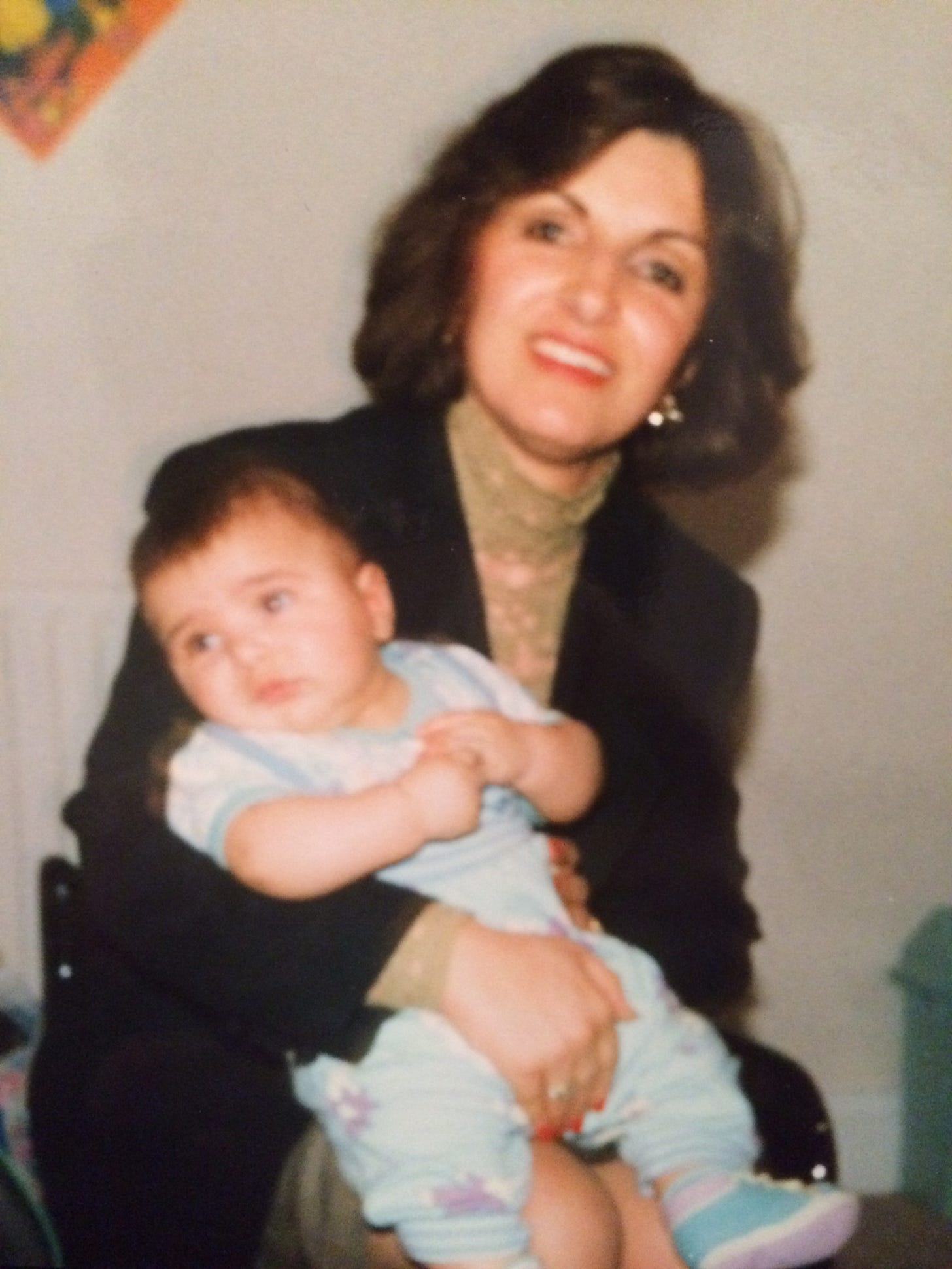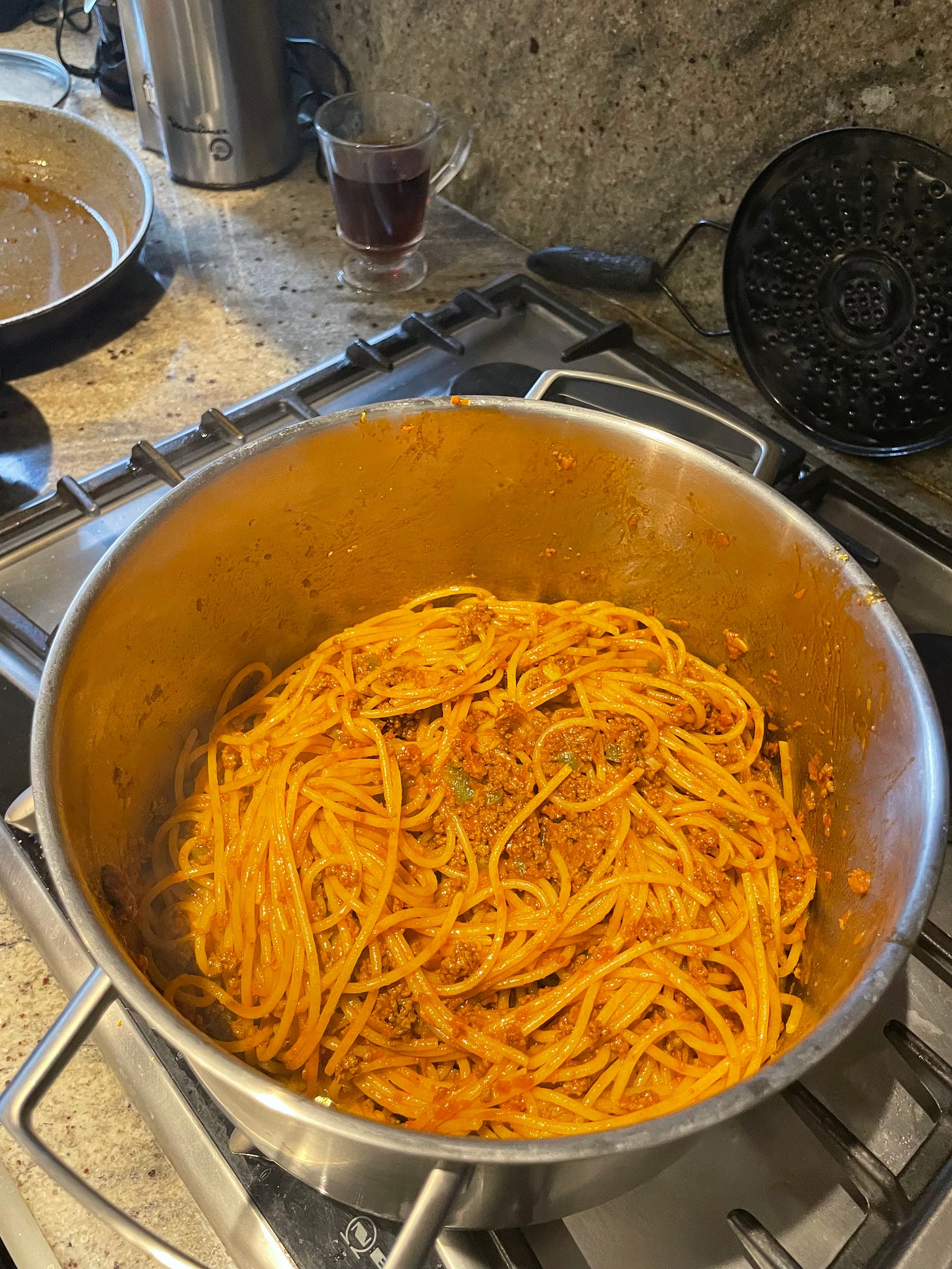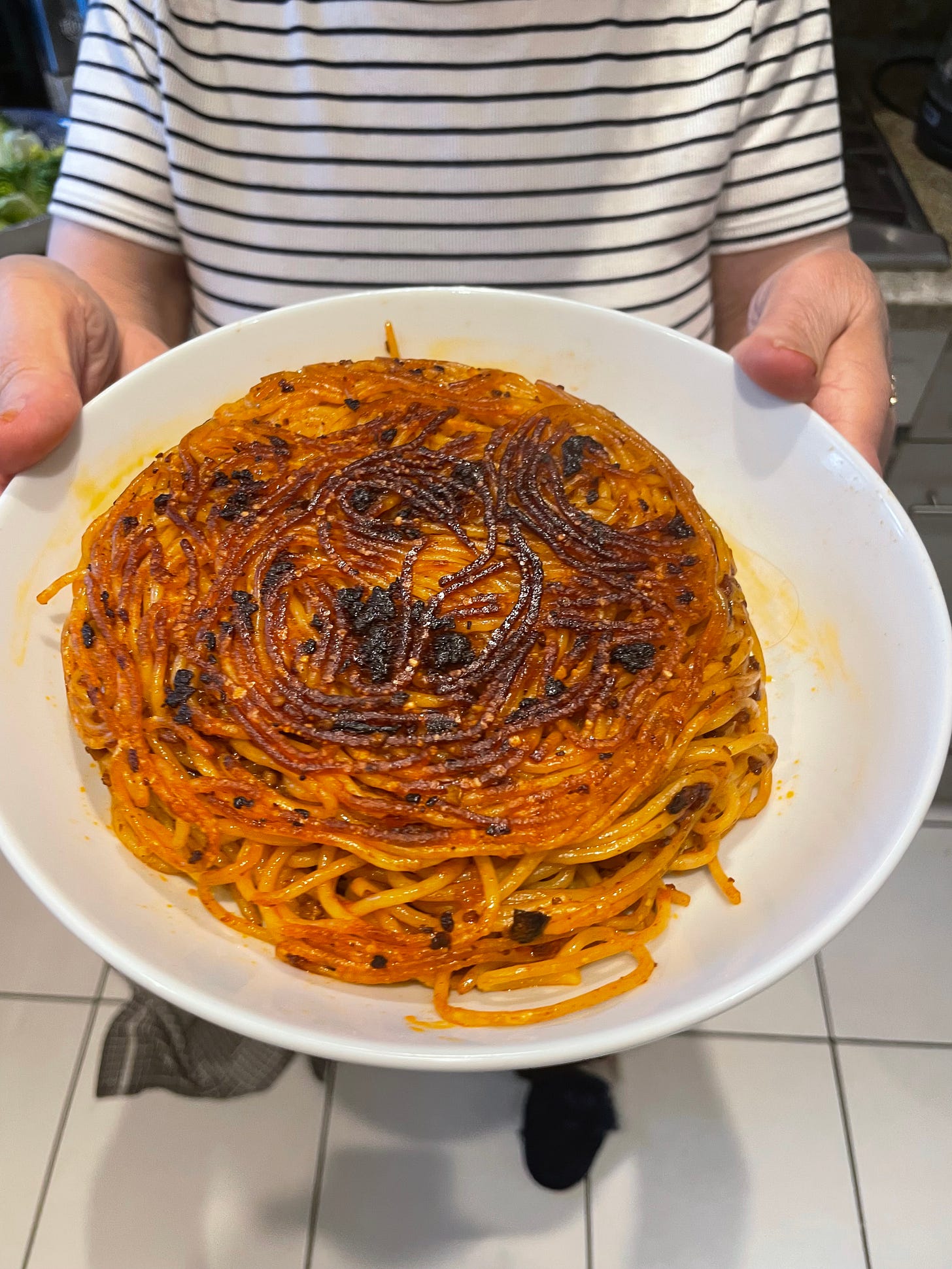Cooking from in the in-between
Aryan Anbari writes about Makaroni, an Iranian dish that resists flattened narratives. Plus a recipe by Aryan's mum, Mahin Rafi’i.
Good morning, and welcome to Vittles! Today, Aryan Anbari writes an essay about tangled identities in the diaspora through Makaroni, a delicious dish from his childhood.
Issue 1 of our magazine is now back in stock and you can order through our website here. If you would like to stock it at your shop or restaurant, please order via our distributor Antenne Books by emailing maxine@antennebooks.com and mia@antennebooks.com
‘Hala ye cheezeh takhasosi behet neshoon meedam! My secret!
Een yeki az oon shortcut-hast ke behet yaad meedam to make life easy when you make ghazah-ye Irani.’
My mum has just slyly unwrapped a chicken stock cube with a wide grin of satisfaction. I’m in her kitchen, having one of my many lessons in how to cook
ghazah-ye Irani, the Iranian food I grew up eating. Despite her policing of the kitchen’s domain, my mum loves to explain how she cooks. Occasionally I’m summoned in to be shown how things are done: how to bloom saffron (using ice, not hot water) or how to build a pot of rice for steaming (as a mound with a peak, with holes to allow steam to escape and the tahdig to crisp). Today, she’s in a boisterous mood, catching her breath between laughter to tell me how funny my aunt has found it that I am here to learn how to make makaroni.
Makaroni is a pasta bake, with bolognese as its sauce. More spag bol than ragù, makaroni is made with a sauce of beef mince, onions, garlic, and tomato paste. Because we’re Iranian, there’s a spice mix in there too, which we call advieh. To make makaroni, some par-boiled pasta is mixed up with this sauce and then steamed on the stovetop in the same way we steam rice: gently, while the bottom crisps up to become tahdig. Unlike its Italian counterparts, makaroni has no real rules: it can be made with any dried pasta, and the spice mix is always put together according to a household’s preference.
Growing up, our small flat in Childs Hill had a kitchen that was entirely open to the hallway, and my bedroom was opposite. The click-click-click of the stove being lit for rice would wake me up in the mornings before school. I’d emerge from my room and routinely inspect the pots sitting on the stove, which took in the whole panoply of food I would come to know as ‘Iranian’. Fenugreek wafting up from the ghormeh sabzi; the chicken, eggs and potatoes lolling in their boiling water ahead of their marriage into salad oloviyeh. On occasion, there was even lamb’s head and hoofs, destined to become kaleh pacheh – a surprise package for the boy who only ate chicken. And then there was makaroni, that familiar mess of pasta, shimmering under a sheen of fat rendered down from mince, the mixture of tomato paste and turmeric dying the whole thing the colour of rust.
Makaroni fed me after school, fuelled hours of playing football in the rain. This is our food, I would think when I looked inside those pots. This is what we eat.
My parents moved to the UK as economic migrants in 1974, but people still presume that they fled Iran during the revolution five years later. Just like many migrants at the time, their priority was to quickly assimilate. They arrived in an era rife with hostility, alongside xenophobic shop signs and Mind Your Language on national TV. Eventually, when newsreels misrepresenting Iran’s popular revolution as a theocratic awakening became commonplace, my parents were treated with a potent mixture of pity and derision. Having left Iran, they had become more Iranian than they had ever felt.
In this new life, they were among a group of bon vivants, fuelled by both the energetic promise of freedom in Britain and a longing to recreate the sociality with which they were familiar back home. They would gather in mehmoonis: lavish get-togethers for which Iranian codes of hosting stipulated that to prepare anything less than twenty-odd dishes – in quantities to feed a neighbourhood – would be tantamount to poor taste. For women, the expectations of Iranian society were impossible to shake off. The burden of hosting, and all it entailed, was theirs to bear.
My mum arrived in Britain with little preparation for this endeavour. Contrary to assumptions, she did not have a mother from whom recipes were passed down by word. Hers died when she was seven, and her stepmothers fed the family while jealously guarding their supremacy as matriarchs in her familial home. There were no recipes handed down, no matrilineal modes of knowledge-sharing that are so often assumed to be automatic in cultures outside Europe. So my mum learned as she went, cooking mostly from memory. Friends and family brought spices, frozen herbs and Iranian rice (though basmati often substituted well) when they travelled from Iran on occasion.
At first my mum learned the classics, dishes that had common recognition among Iranians in the diaspora – ghormeh sabzi, zereshk polow, khoresht-e-gheymeh. By the time I was born in 1990, she had become prodigious. My first birthday has often been held as a testament to her skill: I have been told there was so much food that a second buffet had to be set up in the hallway, and her mastery of these dishes was such that she was asked to set up a stall at Oriental City on the occasional Sunday. But life had changed dramatically. My dad’s lust for Western prosperity had failed him. He found relief in alcohol and eventually succumbed to its grip. This meant that my mum was now raising a child alone while working full-time, and many of the friends with whom she had once shared weekends retreated into busy professional and familial lives. The mehmoonis became fewer and farther between. Cooking became much more about getting by.
Still, to my teenage self, what my mum did in her kitchen was nothing short of alchemy. In the morning, or after twelve-odd hours at work, she would produce what felt like luxuries. Of course, those classics were still present, but time was now in limited supply, and she got inventive. Aside from makaroni, there was morgh – a dish simply called ‘chicken’, fashioned out of little more than that, diced onions and any spice she could throw at it; omelet-e Irani, a breakfast food of her childhood, made out of eggs scrambled with tomatoes and whatever else was at hand; kabab digi, a kofte-like log fashioned out of shop-bought burgers and fried in a pan; and anything that could be eaten with polow as its base: chopped-up sausages, leftover potatoes from a roast, and – a personal favourite – shop-bought chicken Kyiv.
By the time I reached adulthood, Iranian cuisine had become popular, subject to the same process of ‘discovery’ as many others. Colleagues sought my validation of the way they pronounced the names of Iranian dishes, or asked if my mum had any tips on how to get tahdig ‘perfect every time’. Increasingly, I found myself performing my Iranianness, constantly oriented in relation to an ‘over-there’ that I had never called home and dislocated from the place that I had. With the uneasy pressure to perform emerged a need to discover a fixed sense of identity, as if I had to authenticate being Iranian. So I sought out codified directions from cookbooks. From these, I learned the classics, the dishes I was supposed to know. I read that ghormeh sabzi was our national dish, so I diligently learned how to make it.
When I finally started to cook alongside my mum, I discovered that her recipes were at odds with the ones in cookbooks such as Food of Life, from which friends learned about Iranian cooking. The everyday dishes my mum cooked – like makaroni – were never included in these books, their absence reinforcing the notion that our food always had to be lavish, opulent or exotic, our lived experiences flattened by pressumptions.
The anthropologist Parvathi Raman has discussed being ‘marked by that migrant malaise’ – a forever questioning of who we are, where we came from, and where we really belong; a sense that our heritage can never be held with lightness. For me, makaroni interrupts this alienation. Its familiarity to British palates uncouples me from a feeling of otherness; it’s different, but only as different as any spag bol, something for which there is always a household-specific recipe yet also no recipe at all. In Iran, too, makaroni made me like my cousins, since we all loved it the same way. It’s the point of balance in two otherwise increasingly disparate senses of self.
As time passed, makaroni slowly disappeared from our dining room table. My mum lived alone while I was at university and stopped cooking pasta of any kind. But even so, it is just about the most Iranian food I know, even if it does not yield to the expectation of performance required from people like me and my mum.
In his poem ‘I Search For You Still’, Kaveh Akbar expresses the longing for a place ‘from within this in-between’. Makaroni, like many other foods, is such a place. Foods like these are the ultimate culinary palimpsests; they make our modern notions of bounded cultures today look increasingly like fragile constructs – their importance lies in resisting attempts to render cultures one-dimensional. While everyone around me defined who I was through their own projections, makaroni reminded me that our selves, made up of our everyday experiences, are ever-changing, a tangled mess of threads from past and present lives.
Mahin’s Makaroni
This recipe will make enough for four hungry, or three ravenous, people. I know the 1:1 ratio of pasta to mince looks ridiculous, but trust me – anything less will render the dish dry and somewhat bland. At the same time, makaroni is not supposed to be saucy and wet; rather, the juices and fat from the mince, along with the pasta’s starch, should help set it with the consistency of a good pasta bake.
Serves 4
Time 1 hr 40 mins
Ingredients
2 tbsp neutral oil, plus a little extra
1 big onion, finely diced
½ green pepper, finely diced
2 garlic cloves, minced
500g minced lamb or beef
1 tsp ground turmeric
1 tsp advieh (see notes)
100g tomato purée
400ml home-made chicken or veg stock (or a stock cube dissolved in 400ml water, as per my mum’s ‘secret’ way)
500g pasta of your choice (we use spaghetti)
a sprinkle of ground saffron (optional – you can use more turmeric instead)
1 potato, sliced into £1 coin-thick rounds (optional, but recommended for the best tahdig, like my aunt used to make)
salt
pepper
Method
Place 2 tbsp of oil in a frying pan and bring up to medium heat. Gently fry the onion for 10 mins, then add the pepper and fry for a further 3 mins, and finally the garlic for 1 min, until everything is softened but not browned.
Add the mince and increase the heat to medium-high. Use a wooden spoon to separate the mince out, stirring constantly so that the moisture evaporates but the meat doesn’t catch.
Once the mince has lightly browned, add the turmeric and fry for 1 min, then add the advieh and fry for another 1 min.
Make a small clearing in the pan. Fry off the tomato purée for about 1 min to intensify its flavour, then combine with everything else.
Add the stock and bring to a boil, then reduce the heat to a gentle simmer. Cook for about 30 mins, until the stock has been absorbed and the slick of fat from the mince is visible in the sauce – what we’d call ja’ oftadeh (falling into place). Season to taste with salt and pepper.



Meanwhile, bring a pot of salted water to the boil for the pasta. Cook the pasta for about 6 mins – long enough that it softens somewhat on the outside but is still very much raw in the middle. If you use spaghetti, it should have given in enough to flop over tongs but still have an element of rigidity.
Drain the pasta from the pan. If making tahdig with the pasta, put some of it (no more than 50g) to one side, then, in a separate bowl, mix the remainder with the meat sauce. Skip this if making potato tahdig.
Oil the bottom of a medium-sized pot (you could use the one you boiled the pasta in) and sprinkle in a touch of turmeric, or, if you’re lucky enough to have some, a pinch of ground saffron. If using potatoes, place the slices across the bottom of the pan in one single layer. For a pasta tahdig, make a single layer using the reserved plain pasta.
Layer the rest of the pasta–mince mixture on top and create a sort of mound, then cover with a lid (ideally with a cloth wrapped around lid to catch any steam) and place over a high heat for 5 mins. Turn the heat down to a medium-low once enough steam has been generated – you should hear the sound of sizzling coming from the bottom – and cook for another 40–45 mins.
Now for the heart-in-mouth moment. Remove the lid and cloth and place a lipped plate or shallow bowl over the top of the open pot. In as quick and smooth a motion as possible, flip the pot over. If all’s gone well, you’ll feel the thud of the makaroni hit the plate, and you can remove the pot to reveal the golden crust of tahdig on the bottom. If your tahdig has stuck to the bottom, don’t worry – it just requires a bit of scraping to break off. It may not be as aesthetically pleasing as you wish, but no doubt it’ll still be crispy and delicious.
Notes
My mum’s advieh includes equal proportions of ground cumin, coriander, cinnamon, rose petals, and dried lime. The rose and lime are not essential, and the flavour of dried lime can be emulated by using ground sumac instead, or by adding a squeeze of lemon to the dish.
Credits
Aryan Anbari is a writer based in London with special interest in exploring migration, diaspora and identity-making through food. He works in restaurants and is a student of Food Anthropology at SOAS, You can find him on Instagram @aryananbari. Aryan has also photographed this piece.
This recipe has been tested by Sanskriti Bist.
The full Vittles masthead can be found here.










What a wonderful piece. Thank-you.
I really enjoyed reading this article. Being a bit of a mongrel, culturally speaking and nationality speaking, myself -- I can identify in some ways. I wish I could be studying at SOAS with you, Food Anthropology sounds very au point. Good luck with all you do!